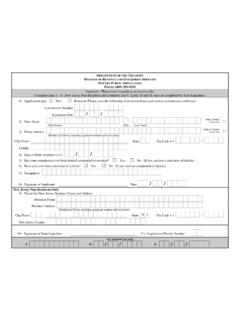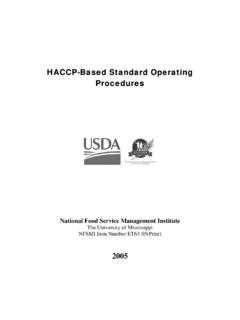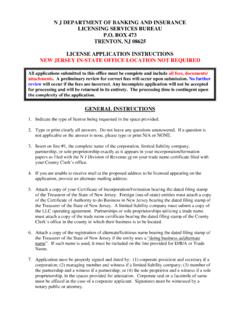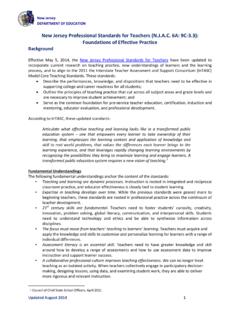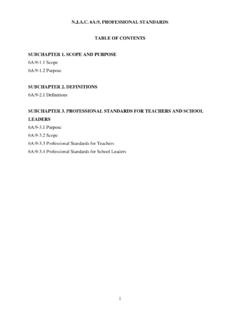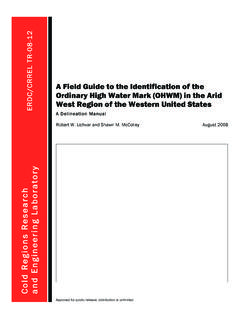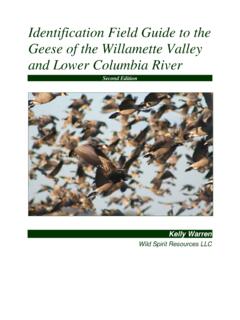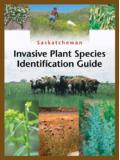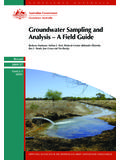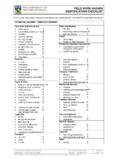Transcription of FIELD GUIDE TO REPTILES AND AMPHIBIANS OF NEW JERSEY
1 NEW JERSEY DEPARTMENT OF ENVIRONMENTAL PROTECTIONDIVISION OF FISH & WILDLIFEENDANGERED & NONGAME SPECIES PROGRAMR obert McDowell, DirectorMartin McHugh, Assistant DirectorLawrence J. Niles, , ChiefFIELD GUIDE TO REPTILES ANDAMPHIBIANS OF NEW JERSEYPREPARED BY: JACKIE GESSNER & ERIC STILES1ST EDITION, February 2001 FUNDED BY: CONSERVE WILDLIFE FUNDS AND FISH & WILDLIFE SERVICE SPARTNERSHIPS FOR WILDLIFESALAMANDERS OF NEW JERSEYM arbled Salamander (Ambystoma opacum)Identification: 3 1/2" - 4 1/4". The Marbled Salamander has light crossbands on a dull black body that aresometimes incomplete and sometimes run together to encircle a dark spot. Females have gray bands while maleshave white bands, both contrasting on the black body.
2 Bellies are black as well. Newly transformed juveniles havescattered light flecks on a background color of dull brown to to find them: This salamander can be found in moist woodlands or in the sandy areas of dry hillsides byturning over logs and to find them: Breeds in autumn, when the female deposits her eggs in a low depression to be filled by thenext : Entire Salamander (Ambystoma jeffersonianum)Identification: 4 1/2" - 7". Jefferson Salamanders look very much like other related Ambystoma salamanders. Keyfield marks are the long toes, long snout, and slender shape. The belly is definitively paler than the sides of the darkbrown or gray back. The limbs and lower sides of the body are usually marked by tiny flecks of blue.
3 These bluemarks are bright on young individuals, but fade with age. While they may closely resemble the Blue-spottedSalamander, Jefferson Salamanders have gray vents that are always paler than those of Blue-spotted to find them: Jefferson Salamanders breed primarily in woodland vernal ponds. Terrestrial adults are foundin rich to find them: Breeds in early : Northern Region: Sussex, Warren, Hunterdon, Morris, Passaic, and Bergen : The Jefferson and Blue-spotted Salamanders hybridize over most of the Northern Region. Within this area,colors and patterns may vary greatly among hybrids and their parents, and definite identification to either species isextremely difficult. Genetic analysis is the only definitive method of distinguishing Salamander (Ambystoma laterale) State Endangered SpeciesIdentification: 4" - 5 1/2".
4 The background of the Blue-spotted Salamander is a bluish black color and it issprinkled with flecks of blue and white. Its spots are on its back, as well as its sides and tail. The area around itsvent is usually black. This salamander does have relatively long to find them: Blue-spotted Salamanders breed in woodland ponds, marshes, swamps, and adults are found in mature woods where there are rotting logs and deep humus, slightly above swampsand marshland to find them: Breeds in late March and early April. Enter hibernation before freezing : All of Northern Salamander (Ambystoma maculatum)Identification: 4 3/8" - 7 3/4". A series of round spots, yellow or orange in color, sprinkle the back of the SpottedSalamander from its eye to the tip of its tail.
5 Its belly is a slate color, while its back and the rest of its body variesfrom black to slate to a bluish black shade. Young Spotted Salamanders may have more of a brown hue. It is rare tofind an unspotted and when to find them: An early spring breeder, known to make mass migrations to vernal breeding wet weather in the autumn and spring, it is possible to find these salamanders hidden under boards and : Entire Tiger Salamander (Ambystoma tigrinum tigrinum) State Endangered SpeciesIdentification: 7" - 8 1/4". The Eastern Tiger Salamander is the largest in New JERSEY . Yellow spots on a dull,black background make it easily confused with the Spotted Salamander. However, the yellow spots on an EasternTiger Salamander are not perfectly round and typically produce more of a barring effect than a spotted one.
6 Thesespots vary in color from bright yellow to olive. Its belly is to find them: A winter and very early spring breeder. These tiger salamanders breed in vernal pools in earlysuccession or those formed in gravel pits. In June, the young metamorphose and move into the surrounding : All of Southern Newt (Notophthalmus viridescens viridescens)Identification: 2 1/4" - 4 13/16". While the Red-spotted Newt has several different life forms, there are always redspots present on its back, up to 21 in number. The aquatic adults vary from yellowish brown to olive to greenishbrown in color. The terrestrial juveniles, also known as red efts, vary from bright orange to dull red. Their brightcoloration warns predators of their poisonous to find them: Aquatic adults may be seen swimming, resting, or crawling through vegetation in ponds,marshes, small lakes, and ditches.
7 The red efts are bold, and can often be seen walking across the forest floor in themiddle of the to find them: Red efts are plentiful after summer : Entire Dusky Salamander (Desmognathus fuscus fuscus)Identification: 2 1/2" - 4 1/2". The tail of the Northern Dusky Salamander is nearly half of its total length and iskeeled. As Northern Dusky Salamanders age, their patterns vary. They are gray or brown in color, and markings ontheir backs look like spots bordered by a wavy to find them: The Northern Dusky Salamander does not wander far from water. They are locally abundantin brooks, springs, and seepage areas where there is debris that provides to find them: Active May through : All of Northern Region. Southern Region: western Burlington, Camden, and Gloucester Dusky Salamander (Desmognathus ochrophaeus)Identification: 2 3/4" - 4".
8 Mountain Dusky Salamanders look very much like Northern Dusky Dusky Salamanders have a single light even stripe running down their backs and tails. Coloration is verysimilar to Northern Dusky Salamanders gray or brown. The row of spots down the center of its back is shaped to find them: This species of dusky salamander wanders far from water during wet weather. UsuallyMountain Dusky Salamanders are found under logs and stones where the ground is to find them: Usually found at night when they are actively : Northern Region: Sussex, Passaic, northern Warren, northwestern Morris, and western Bergen Salamander (Plethedon cinereus)Identification: 2 1/4" - 4". The Redback Salamander comes in two distinct forms: (1) redback a straight redstripe running from base of head, down the back, to the tail and bordered by dark coloration (stripe is sometimesorange or even light gray); (2) leadback (lead phase) uniform dark gray or black color.
9 In both forms, thecoloration looks mottled or speckled. Bellies are mottled with black and a white or yellow color. An all-redvariation is found to find them: The Redback Salamander is quite common throughout most of its range, and is found inwooded areas under logs, bark, stones, and even to find them: Most often seen on rainy : Entire Slimy Salamander (Plethedon glutinosus)Identification: 4 3/4" - 6 3/4". The Slimy Salamander secretes a substance that sticks to hands like glue. It is blackin color with silver-white spots and/or brilliant golden flecks. Their bellies are lighter than their to find them: Moist woodland ravines or to find them: Active April through : All of Northern Region and northwestern Monmouth County in the Southern Salamander (Hemidactylium scutatum)Identification: 2" - 3 1/2".
10 The Four-toed Salamander has three distinct characteristics. First, its belly is white withbold black spots. Second, both the hind feet and the fore feet have four toes whereas most salamanders have fivetoes on each hind foot. Third, there is a marked constriction at the base of the Four-toed Salamander s to find them: Adult Four-toed Salamanders are primarily aquatic as adults, usually being found insphagnum to find them: Active April through : Entire Spring Salamander (Gyrinophilus porphyriticus porphyriticus)Identification: 4 3/4" - 7 1/2". The Spring Salamander has a reddish coloration either salmon or light brown witha reddish tinge. The sides of their bodies are a darker shade that forms a netlike pattern, enclosing light spots ontheir bellies and throats.


